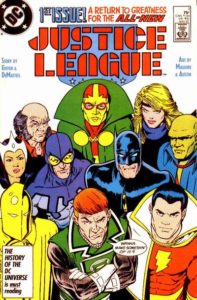The “Gritty Levity” of Justice League

Justice League—the latest star-studded adaption of the DC superhero franchise—is closing out its time in the box office this December. Although the film underwhelmed both critics and audiences, one critic called it “a good balance of light and dark”—an assessment that fits with the spirit of the comic’s 1980s iteration.
This year, College of General Studies Senior Lecturer Charles Henebry published a chapter in The Ages of the Justice League: Essay’s on America’s Greatest Superheroes in Changing Times (McFarland, 2017). In the chapter “Gritty Levity: The Giffen/DeMatteis Era of the Justice League,” Henebry looks at the 1987 relaunch of Justice League and its place in a new “grim ’n’ gritty” trend of comics like The Dark Knight Returns and Watchmen. Like these comics, the Justice League “crafted stories that questioned whether superpowers could solve the world’s profound sociopolitical problems,” Henebry says. The key difference, though, is that Justice League “did so to comic effect.”
The Justice League drops “of America” from its name and goes international in 1987, taking on terrorists and becoming “a genuinely international organization,” Henebry writes. A businessman named Maxwell Lord becomes a central, shadowy figure, tapping into what Henebry calls “a shared anxiety over the growing power of international corporate media to shape global events.” The heroes confront the physical limits of their powers, sometimes to comic effect, and the media’s power becomes a running theme. Looking at the context, Henebry concludes the series capitalized on a new market for “adult-themed comics” by “embracing the silliness of the superhero tradition while at the same time mocking and subverting it.”
Read more of Henebry’s essay—and other perspectives on the Justice League—in The Ages of the Justice League, praised as “an exceptional study that is highly informative, critically brilliant, and fun to read.”